Monarch butterflies and milkweed. We’ve explored the subject many times right here at the Texas Butterfly Ranch. But author Anurag Agrawal’s recently published Monarchs and Milkweed, A Migrating Butterfly, a Poisonous Plant, and their Remarkable Story of Co-evolution adds a new dimension to our understanding of the testy relationship between our favorite migrating butterfly and its poisonous host plant.
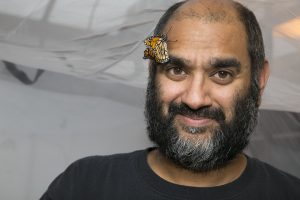
Anurag Agrawal, author of Monarchs and Milkweed, released this spring by Princeton University Press –Courtesy photo
Agrawal, a recipient of the prestigious MacArthur Ecology Award in 2016, wades far into the milkweeds to make this complicated story highly readable. The Professor of Ecology and Evolutionary Sciences and Faculty Fellow at the Atkinson School of a Sustainable Future at Cornell University was the first scientist to suggest that Monarch butterfly conservation might be better served if we looked beyond planting more milkweeds–anything in the Asclepias family. Agrawal proposed increasing late season nectar plants, required by the butterflies in the fall to fuel their migratory flight.
In this beautifully illustrated book, he compares the co-evolution of milkweeds and Monarchs to an “arms race,” a parallel drawn previously by Monarch butterfly expert Lincoln Brower and other scientists.
To Monarch butterfly lovers, the metaphor may seem off-putting, perhaps exaggerated. But after reading Agrawal’s detailed explanation of the continuous one-upmanship that occurs between the iconic creature and its host plant, the label makes perfect sense.
One of Agrawal’s most unexpected assertions: “The butterflies are simply no good as pollinators. Monarchs are strictly pests.” With Monarch butterflies bandied about as the poster child for pollinator advocacy in recent years, we naturally assume that the storied migrants are effective pollinators.
But they’re not. Especially for milkweeds, which have an unusual pollinator strategy, similar only to orchids in the natural world. Milkweed pollen is not disseminated by individual pollen grains like those we notice clinging to the bodies of bees.
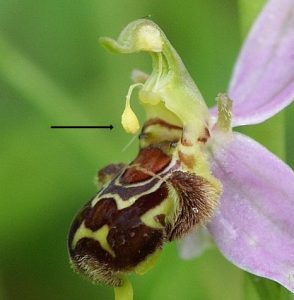
The dangling yellow pollen sac is the pollinium of an orchid. Photo via Wikipedia
Instead, members of the Asclepias family reproduce via pollinia, evolved pollen packages–sticky masses of pollen that look like tiny yellow bags. We sometimes see these teeny yellow bulbs attached to bees’ wooly heads or fuzzy legs after they’ve dug into a flower. The pollen sac attaches to the bee. As they dive into flowers, the pollinia somehow is inserted into the flower’s reproductive slit, resulting in pollination.
Monarch butterflies, because of their size, form, and the way they sit atop flowers, simply don’t have the capacity to carry these hefty pollen vessels. And they rarely come into contact with the pollinia, nor its reproductive destination in the female part of the flower.
“This nonpollinating aspect of Monarchs is not widely appreciated,” writes Agrawal.
Now there’s an understatement. Given the Monarch’s Pan-American status as the great pollinator ambassador, that fact will come as a harsh revelation to many.
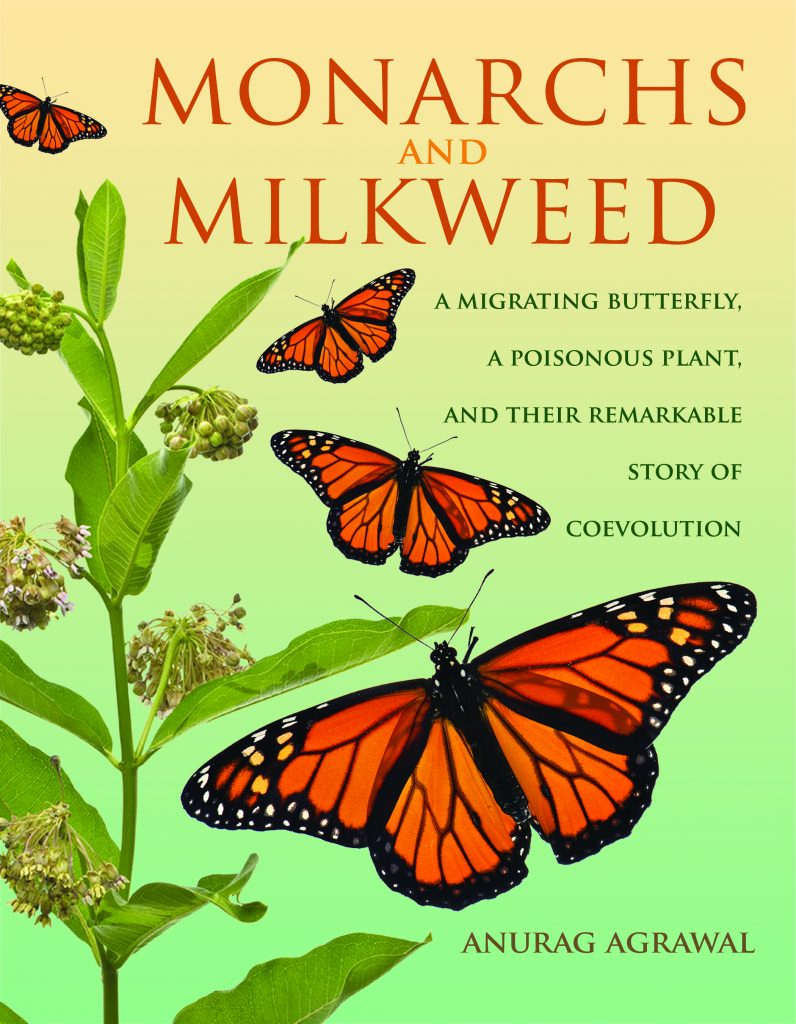
Agrawal will be in town for a session at the San Antonio Book Festival April 8. Come join us, buy a book, and get it signed.
As it happens, milkweeds don’t need Monarchs, but Monarchs DO need milkweeds. Monarch butterflies will only lay their eggs on plants that are members of the Asclepias or milkweed family, a species known for its sticky, milky latex sap, which tastes bitter and contains potentially heart stopping toxins that protect the butterflies that consume it as caterpillars because it makes them distasteful to predators.
Monarch caterpillars eat the milkweed leaves, morph through their stages, transform into chrysalises, then emerge as adult butterflies. As the Monarchs attack the milkweed by eating it, the milkweed responds by ratcheting up its toxic properties, making the larval food ever more toxic as the season wears on. This is how the plant protects itself and makes for the intriguing “coevolutionary arms race” which is the premise of the book.
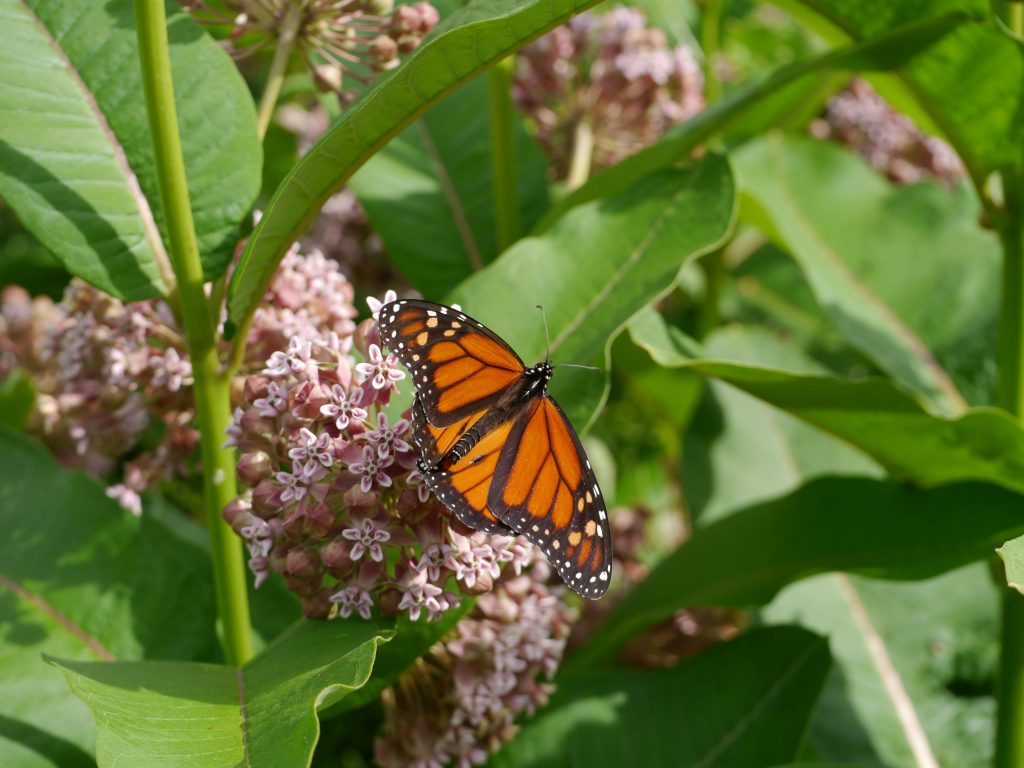
Monarch butterflies will only lay their eggs on the toxic milkweed Asclepias species. Courtesy photo
Agrawal notes, and some of us have witnessed first hand, how tiny Monarch caterpillars sometimes perish upon eating perfectly healthy milkweed. The reason may be the milkweed is simply too toxic for the Monarchs to process. As Agrawal points out, “the dose makes the poison.”
In chapter seven, titled “The Milkweed Village,” Agrawal goes into entertaining detail about the 11 different species of insects that have made milkweed “their bed and breakfast.” We’ve seen them all–aphids, milkweed bugs and beetles, wasps, ants. Agrawal introduces each in gory and glorious detail–the “seed eaters,” the “suckers,” the “chewers, miners and borers.” For anyone who raises Monarchs and milkweeds in the garden, many questions will be answered here.
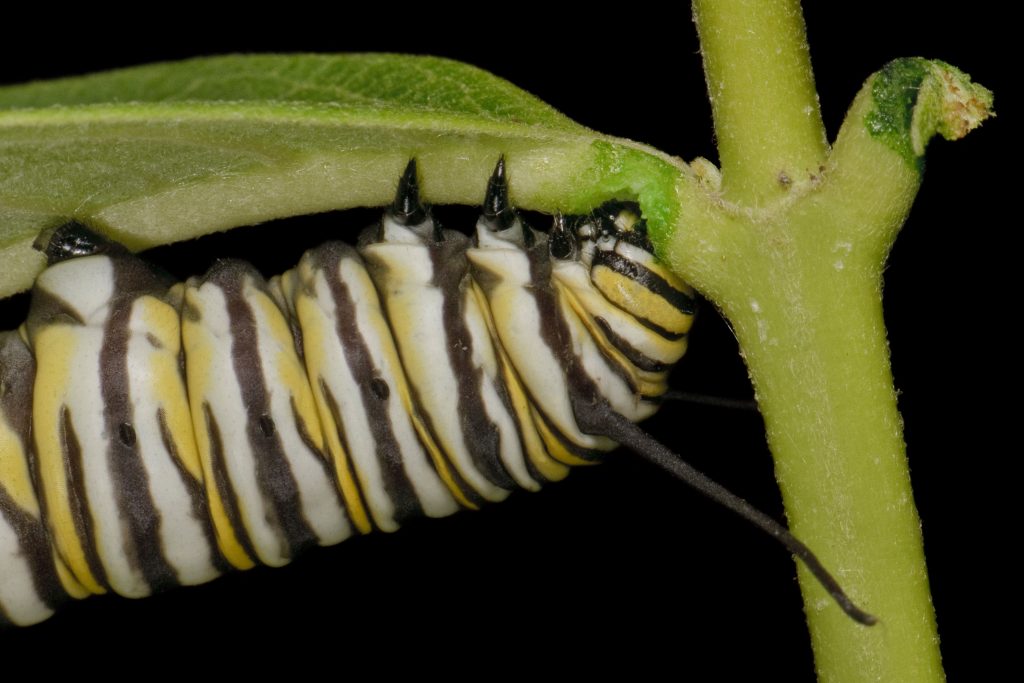
As Monarch caterpillars decimate milkweeds, the plant responds by increasing the levels of cardiac glycosides it produces as a defense. Courtesy photo.
Throughout, Agrawal writes deeply but accessibly about biology, botany, and chemical ecology, only rarely straying into the hyper-scientific jargon that can make such writing impossible to understand for those without PhDs. That is one of the greatest strengths of this book in my view: making the science understandable to nonscientists.
Speaking of eating milkweed, Agrawal also shares that young stalks of certain milkweeds are perfectly edible as a side dish for humans. I had heard this from my friend, hydroponic farmer and adventurous vegetarian Mitchell Hagney of Local Sprout, but had never had it explained.
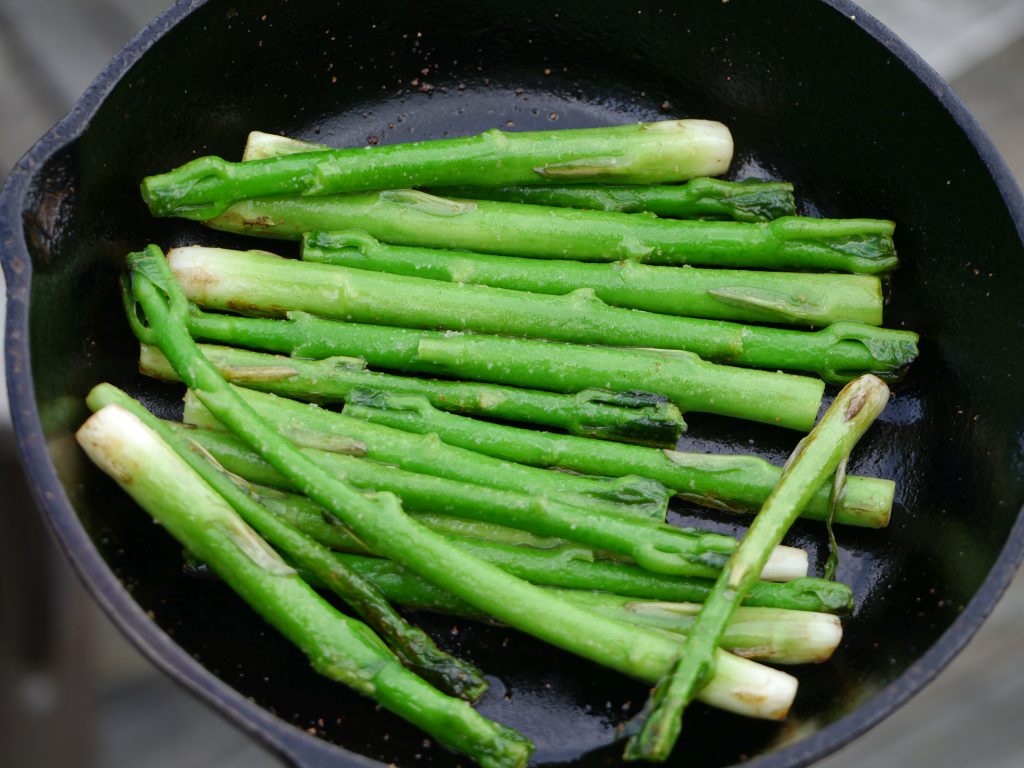
Anurag Agrawal cooked milkweed for his wife and child. Courtesy photo
Agrawal cites wild plant proponent Euell Gibbons, author of the 1962 classic, Stalking the Wild Asparagus. Young milkweed shoots can apparently be gathered in late spring when they’re four- to eight-inches high, sautéed and served for supper or as a side dish. Agrawal suggests several cold water rinses to remove extreme bitterness from the milkweed but preserve its unique flavor.
“Season with salt, pepper and butter. Serve proudly,” he writes. He offers a color photo of a cast iron skillet filled with young milkweed shoots that he served to his family. The Asclepias veggies appear amazingly similar to asparagus. Perhaps a milkweed cookbook will be next?
Such accessible, fun anecdotes mixed with hardcore science are exactly what make this book a must-read for Monarch followers and generalists alike.
Want to meet Anurag Agrawal? Join us at the San Antonio Book Festival Saturday, April 8, 10 AM, to meet him. We’ll discuss his book and answer your questions. Books will be available for purchase and signing. Hope to see you there! Details here.
Related posts:
- Q&A: Anurag Agrawal challenges Monarch conservation conventional wisdom:
- Climate change and Monarch butterfly migration symposium tackles tough questions
- Climate change expert Katharine Hayhoe at TribuneFest: “Hopelessness is hopeless.”
- Coming soon: Grupo Mexico copper mine in heart of Monarch butterfly roosting sites?
- Scientists try to assess Monarch butterfly mortality after Mexican freeze
- How to plan a successful butterfly and pollinator garden
- Mostly native butterfly garden outperforms lawn every time
- Tropical Milkweed: To Plant it or Not is No Simple Question
- How to raise Monarch butterflies at home
Like what you’re reading? Don’t miss a single post from the Texas Butterfly Ranch. Sign up for email delivery, like us on Facebook, or follow us on Twitter, @monikam.

Beautiful article, Monika, about wonderful new book! Can’t wait to order it today. Thank you for your dedication to bringing new and important information about raising milkweed and keeping the monarchs healthy and alive to us. I love your website and read every email I get. Thank you again! Hail to the Monarchs!!!
Please join us at the SABookfest to meet Anurag Agrawal! Thanks for reading and writing, too. –MM
Why can’t I find an source for inexpensive Milkweed plants near St. Louis, Missouri?
I could never eat my millkweeds! They are too beautiful and besides they need to grow for the monarchs to eat. Maybe if I ever get a larger patch I could sacrifice a few, but it would have to be a really big patch. I am trying to get as many different milkweeds as I can so they have a variety to munch on.
Help with milkweed needed.
I am in Los Angeles and I purchased four milkweed with baby caterpillars on each and just after a few days many leaves have turned yellow and are dropping off. The milkweed is in the house in a filtered sunny spot. I lightly water. What’s happening? Can the caterpillars eat the yellow leaves? I fear there will not be enough green milkweed leaves for them.
I have started a new hobby:Monarchs. Read all I could written by you about raising Monarchs. Got hooked. Bought 14 Milkweed plants. Bought a cage and my first egg has reached the chrysalis stage. Very exciting feeling like a “father-to-be”.
Thank you for my schooling.
Oh yeah, I’m 80 years young. A retired Army officer. Nothing better than this! (The website is my wife’s.The Nerd.)
[…] Agrawal, author of Monarchs and Milkweed: A Migrating Butterfly, A Poisonous Plant and their Remarkable Story of Coevol… agreed with Taylor that the commercially bred recoveries “are teaching us something new about […]
Greg in Clarkston Michigan writes…
I planted several varieties of Milkweed from seed.
Late August now and they have buds and yellow aphids.
I squish them to the yellow juice from whence they came.
No Monarch eggs or caterpillars.
When might this Great Almighty Monarch, that rule the skies,
use these plants I put infor them?
I was thinking that they would all con
Gregate on Greg’s Milkweed garden,
instead of making that long trip to Mexico, risking getting
killed by some cheap fricken alcohol the’re serving there.
Or is this a wasted effort, like most projects I Start?